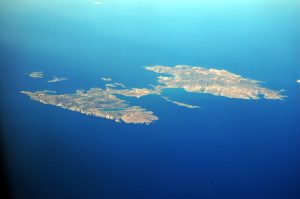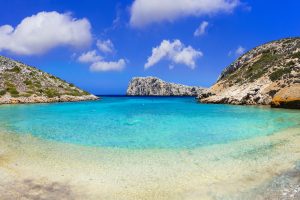ASTYPALEA
A bridge between the two major island complexes of the Aegean Sea, the Dodecanese (to which it belongs) and the Cyclades, Astypalea has many Cycladic elements: the anhydrated landscape with the shrubs, the acropolis with the whitewashed houses around and the picturesque chapels in every corner .
According to mythological tradition, the island owes its name to Nymph Astypalaia, daughter of Phoenix and Poseidon’s wife. Astypalea was inhabited since Prehistoric times. Its first inhabitants are the Kares and later the Minoans. During Hellenic Times, Astypalea developed great naval activity and became known thanks to its rich fish (“fish”) and its abundant agricultural products. During the Byzantine Times or Astypalaia belonged to the Province of the Islands, and after 1204 fell into the hands of the Venetians, who preserved their sovereignty (except for a short period) until 1537.
The capital of the island, Chora, is built on a hill that enters the sea, forming two mountains: the port (Pera Gialos) and the Livadia meadow. At the top dominates the castle with the dark local stone, where the Virgin of the Castle (Evangelistria) and Agios Georgios emerge. The inhabitants are the houses that tighten the castle giving Cycladic color to the settlement, while at the edge of the hill stand the well-preserved windmills, the golden Chora.
The castle of Chora, the Venetian castle of Kourini, belongs to the architectural aspect of the fortified settlement type, with the external houses creating a wall with small windows for jams.
The religious monuments that stand out are the church of Panagia Portaitissa (middle of the 18th century), with a wooded iconostasis and a beautiful bell tower, one of the most beautiful in the Dodecanese, and the Great Virgin Mary, with a mountain floor in the courtyard.
Significant are the exhibits of the Archaeological Museum of Astypalea, dating back to the Prehistoric to the Medieval years (among others, findings from Mycenaean tombs, the treasure of silver coins of Classical Times, sections of early Christian basilicas, marble coat of arms of the Kournini family from the castle of Chora).
Outside of Chora are the monastery of Panagia Flevariotissa (6 km northwest), built on a sloping slope, and the monastery of Agios Ioannis (12 km D), built in imposing area overlooking the sea (across from the monastery lies the came under the local tradition of Ai-Giannis Castle).
Close to Chora are Livadia, a seaside settlement, spread out in a fertile valley, in the middle of the homonymous bay.
Northeast of Chora lies Analipsi, also known as Maltezana, a seaside settlement spread over a small valley with fine sand. You will be enchanted by the nearby islands of Hondros, Lignos, Agia Kyriaki, Koutsomiti, Kounoupes and Syrna where you can transfer with the beautiful small boats from Maltezana but also from Chora …
The interest of the visitors of Ascension brings together the remains of the Early Christian Basilica, where St. Barbara is located, the oil paintings and the church of Ascension.
In the southeastern part of Astypalaia there is a closed and deep bay that resembles a lagoon, Vathy. The two small settlements are Messa Vathi, at the entrance of the orium, with a small nose for the boats, and Exo Vathi, at the foot of the rush.
A special experience is a boat trip in the valley of Negros (at Vatsi bank, on the south coast of the island) and in the cave of Drakou (at the northern end of the island).
For swimming we recommend the beaches Blue Limanaki, Livadia, Tzanaki, Moura, Papou, Agios Konstantinos, Votses, Kaminakia, Agios Ioannis, Panormo, Pachia Ammos, Analipsi, Schinonta, Kareklis, Vrissi and Vathi.




